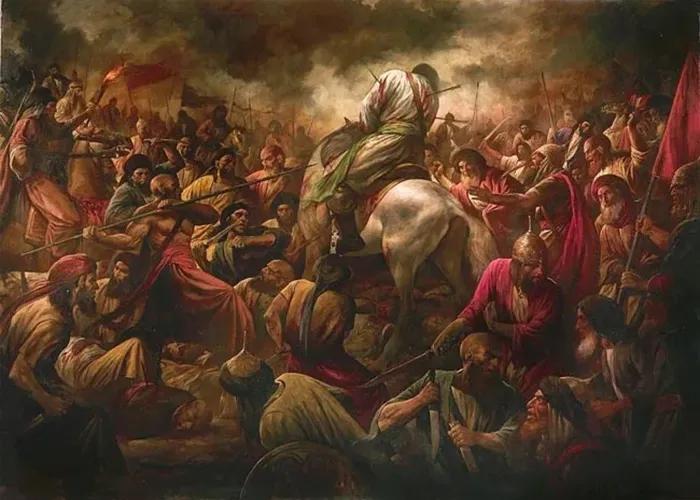Topic of the Week – Volume02 Issue30
Hidden Economic Corruption: A Root Cause of the Tragedy of Karbala
Seyed Hashem Moosavi
Introduction
Over the years, many books have been written, and various theories have been proposed to explain the causes and roots of the Karbala uprising. Among the widely discussed factors are the deviation of the influential elite, the political consequences of the Saqifah event, the gradual neglect of the Prophet’s revolutionary ideals (peace be upon him and his family), and the growing materialism of the general public and the political elite.
However, one of the most concealed yet foundational dimensions of the tragedy of Karbala, which underlies many of the causes above, is the profound transformation that occurred in the Islamic economic system and Muslim society’s lifestyle.
It can be argued with confidence that many of the surface-level causes of the Ashura event are symptoms of a deeper problem: the distortion of Islamic economic principles and the emergence of an unjust class-based system. These developments paved the way for widespread corruption, inequality, and the eventual moral collapse that made the martyrdom of Imam Husayn (PBUH) possible.
The Rise of Capitalism in the Early Islamic Society
The seeds of a capitalist mindset within the Muslim community were sown shortly after the caliphs assumed power. The first significant and formal manifestation of this economic orientation appeared during the rule of the second caliph, ʿUmar ibn al-Khaṭṭāb, particularly in the way public wealth (Bayt al-Māl) was distributed.
A critical turning point was the establishment of the Dīwān al-ʿAṭāʾ (or Dīwān al-Jund) during his caliphate.[1]. This administrative office was responsible for distributing war booty and public funds. However, under the Caliph’s orders, the distribution was no longer equal among Muslims. Instead, it was based on hierarchical criteria such as tribal lineage, proximity to the Prophet (peace be upon him and his family), and the length of one’s service to Islam.
This policy effectively laid the groundwork for an unjust class-based society within the young Islamic community. The egalitarian spirit of the Prophet’s message was undermined by prioritising certain groups over others in financial matters, and economic disparity began to take root, marking a significant departure from the original Islamic vision of social justice and equity.[2]
This policy gave rise to a new social and political class within the Muslim community-one that came to control a significant share of the state’s wealth and revenues. This emerging elite primarily consisted of the Qurayshi nobility and influential figures among the early supporters of Islam.
The sweeping conquests during ʿUmar’s caliphate, across Persia, Byzantium, and North Africa, poured immense and unprecedented wealth into the Arabian Peninsula. However, through the mechanisms of the Dīwān al-ʿAṭāʾ, the lion’s share of these fortunes ended up in the hands of this privileged class, particularly the prominent Companions who held high political and social status.
The Domination of a Privileged Aristocracy During the Third Caliphate
During the caliphate of ʿUthmān ibn ʿAffān, the capitalist tendencies within the Islamic government grew stronger and took deeper root. It became increasingly apparent to the public that a specific group, mainly prominent Companions and Qurayshi elites, used their unchecked political influence to amass wealth exponentially.[3]
A mindset of aristocratic entitlement began to pervade the ruling class, with senior officials competing for greater comfort and material luxury. Social merit was measured not by piety or moral integrity, but by the extent of one’s wealth and possessions.
In an atmosphere where the spirit of Prophetic simplicity and contentment had been forsaken, replaced by aristocratic entitlement and systemic discrimination, any figure loyal to the Prophet’s model (PBUH) and committed to restoring the just economic system of Islam was either sidelined, exiled, or placed under heavy restrictions.
Imam ʿAlī (PBUH), Salmān al-Fārsī, Abū Dharr al-Ghifārī, and other faithful companions of the Prophet were either forced into seclusion or sent into exile. In their place rose individuals like Muʿāwiyah and the sons of al-Ḥakam ibn Abī al-ʿĀṣ, himself exiled by the Prophet, along with other aristocratic Qurayshi elites.
One striking example of this elitist policy was ʿUthmān’s lavish gift of one hundred thousand gold dinars to al-Ḥakam ibn Abī al-ʿĀṣ, and his granting of the entire khums (one-fifth share) of the spoils from the North African campaigns to the descendants of Marwān ibn al-Ḥakam.[4]
In this way, the wealthy elite and Qurayshi aristocrats entered the realm of large-scale land trade and acquisition. They seized control of vast and fertile lands across Iraq, Persia, and the Levant. It was as if the imperial estates of the Sassanid and Byzantine emperors, those of Khosrow and Caesar, had been revived again, this time under the guise of Islam.
The Emergence of Entitled Elites (Āghāzādegān) and Their Destructive Consequences
The immense wealth accumulated by particular Companions and Qurayshi elites eventually paved the way for the arrogance and corruption of their descendants, what might today be called a class of “entitled elites” (Āghāzādegān). These heirs followed in their fathers’ footsteps, purchasing and selling estates and orchards, sparing no effort in the pursuit of greater riches.
The historian al-Ṭabarī reports that these privileged offspring of the Companions became active agents of moral decay within the Islamic society, triggering widespread public outrage. Numerous complaints were submitted to the caliphal court, yet due to the profound influence these individuals held within governmental and judicial institutions, those grievances were left unresolved, further fuelling popular discontent.
Corruption became so pervasive that Caliph ʿUthmān was eventually compelled to exile some of these figures to Syria and other distant provinces to quell the unrest.
The increasing corruption of the elite and their entitled offspring, the severe class-based discrimination, the spread of poverty and despair among the deprived masses, and, most importantly, the conduct of rulers in apparent contradiction to the revolutionary path of the Prophet (PBUH), were like a fire that engulfed the caliphate of ʿUthmān.
The people’s anger over ʿUthmān’s actions and the support he received from wealthy Companions led to widespread uprisings across various parts of the Islamic world. The peak of these revolts occurred in the capital, Medina, where the caliph’s palace was besieged, ultimately resulting in ʿUthmān’s brutal killing.
The root of all these seditions must be traced to the establishment of the unjust Dīwān al-ʿAṭāʾ system and the promotion of aristocratic capitalism.
The Caliphate of Amīr al-Muʾminīn ʿAlī (PBUH) and the Struggle Against Capitalism
With the beginning of the caliphate of Amīr al-Muʾminīn ʿAlī (PBUH), a new sense of hope was revived in the hearts of justice-seeking people. Weary of oppression and injustice, they placed their hopes in Imam ʿAlī’s pursuit of justice and entrusted the caliphate to him.
From the very outset of his rule, Imam ʿAlī (PBUH) made his position clear regarding ill-got wealth and the usurpation of public funds. He ascended the pulpit and declared:
“Even if public wealth has become part of your wives’ dowries or turned into earrings in their ears, I will reclaim it.”
He even swore that if his sons, Imam Ḥasan (pbuh) and Imam Ḥusayn (pbuh), were to seek any unjust advantage from the government’s resources, he would cut off their hands.
The economic policy of Imam ʿAlī (PBUH) was founded upon three main principles:
- The dissolution of the class-based Dīwān al-ʿAṭāʾ system
- The equal distribution of public funds (Bayt al-Māl) among all Muslims
- The recovery of illegitimately acquired wealth from particular Companions and its return to the public treasury
The wealthy Companions, accustomed for years to special privileges, never imagined that the sharp blade of ʿAlī’s justice (PBUH) would reach them. Assuming the Imam would govern as the previous caliphs had, they initially requested a greater share of Bayt al-Māl. But when confronted with the Imam’s firm stance, they rose in opposition and took up arms against him.
The Battle of Jamal was, in reality, the first armed confrontation against Imam ʿAlī’s economic policies. At its core, the conflict did not stem from political disagreements, but from a clash between the material interests of this privileged group and the Imam’s commitment to economic justice.
From the Isolation of Justice to the Consolidation of Umayyad Capitalism
A society that had become accustomed to and accepting of an aristocratic capitalist system over many years found it difficult, even bitter, to endure the justice of ʿAlī (PBUH). Gradually, many people, including some former companions, began to gravitate toward Muʿāwiyah, who upheld and perpetuated the same Dīwān al-ʿAṭāʾ system and class-based privileges. In this way, Muʿāwiyah’s power continued to grow day by day.
Imam ʿAlī’s (PBUH) continuous efforts to reform economic affairs, restore religion to its original status, and unify the army in opposition to the Qurayshi aristocracy progressed with great difficulty due to the depth of corruption and people’s material dependencies. Eventually, the explosion of discontent, fuelled by the elite, culminated in the event of arbitration (ḥakamiyyah), which led to the fragmentation of the Imam’s army and the emergence of the Khawārij sect.
The arbitration event, followed by the martyrdom of the Commander of the Faithful (PBUH), paved the way for Muʿāwiyah’s rise to unchecked power, he who now called himself Amīr al-Muʾminīn. Through the same economic policy of bribery and financial inducements, Muʿāwiyah had already succeeded in imposing a peace treaty on Imam Ḥasan (PBUH). He quickly became the unchallenged ruler of the Muslim world and began to promote the aristocratic capitalist system with even greater intensity and breadth.
In effect, the Islamic revolution of the Prophet (PBUH) had officially fallen into the hands of the unworthy and unfit. The Prophet’s ideals were increasingly marginalised, and the face of Islam was being alarmingly transformed.
Ḥusayn ibn ʿAlī (PBUH) and an Uprising to restore the Prophetic Ideals
The rule of Muʿāwiyah, and later Yazīd, had so severely distorted the face of Islam that neither the public nor even the elite hesitated in openly violating Islamic laws. The consumption of alcohol, prostitution, gambling, and entertainment had become widespread, and whispers of disbelief and a return to certain pre-Islamic rituals could be heard.
In such a corrupt and degenerate environment, rooted in an unjust economic system and the concentration of wealth in the hands of the elite, Imam Ḥusayn (PBUH) rose to revive the principle of enjoining good and forbidding evil, to reform the nation of his grandfather, and to stand against this systemic corruption.
This identification of the root causes can be confirmed in the words of Imam Ḥusayn (PBUH) himself and in historical reports:
1. In addressing the enemy’s army, Karbala said: “Do you know why you do not listen to my words with your hearts? It is because unlawful morsels from the public treasury have accumulated beneath your skin.”[5]
This statement explicitly points to economic corruption and the usurpation of public wealth (Bayt al-Māl) as barriers to perceiving the truth and accepting divine guidance.
2. Al-Ṭabarī narrates those four individuals who met the Imam on his way to Kufa, in response to his question about the people’s situation, said: “…As for the nobles and tribal leaders of Kufa, they have received the heaviest bribes from Ibn Ziyād. And as for the rest of the people, their hearts are with you, but their swords are against you.[6].”
This report clearly illustrates how financial corruption had bought off the societal leaders and left the masses intimidated and passive.
3. Imam Ḥusayn’s (PBUH) conversation with ʿUmar ibn Saʿd: On the night of ʿĀshūrāʾ, during a negotiation, Imam Ḥusayn (PBUH) invited ʿUmar ibn Saʿd to turn back to God and abandon support for the Umayyads. Instead of responding to the call of truth, ʿUmar ibn Saʿd made material excuses: his fear of his house being demolished, the confiscation of his lands and orchards, and threats to his family’s safety in Kufa.[7].
This exchange is a clear example of how material interests and economic dependencies could override faith and conscience, even when standing before the grandson of the Messenger of God (PBUH).
Conclusion
A deep analysis of the sequence of events from the passing of the Prophet (peace be upon him and his family) to the tragedy of Karbala reveals that the transformation of the Prophet’s just economic system (PBUH) into an aristocratic capitalist order, centred around the Dīwān al-ʿAṭāʾ, led to the rise of a newly wealthy and corrupt class that prioritized material interests over Islamic values.
This systematic economic corruption gradually pushed society toward moral decay, severe class-based inequality, the dominance of money and bribery, and a departure from the Prophetic path and tradition. Ultimately, it gave rise to a tyrannical rule willing to wage war against the very grandson of the Messenger of God (PBUH) to preserve its power and wealth, culminating in the catastrophe of Karbala.
Thus, economic corruption and the unjust system of wealth distribution were not merely contributing factors, but rather deep and hidden roots in the formation of the tragedy of Ashura. The uprising of Imam Ḥusayn (PBUH) was a sacred endeavour to break this cycle of corruption and to restore society to the justice-oriented economic model of the Prophet (PBUH) and Amīr al-Muʾminīn (PBUH), and to reestablish the sovereignty of divine values.
[1] . Aḥmad ibn Yaḥyā al-Balādhurī, Futūḥ al-Buldān, pp. 449–451
[2] . Naṣer Rafīʿī Moḥammadī, “A Study on the Bayt al-Māl,” Farhang-e Jahād Quarterly, Issues 41–42.
[3] . “Bayt al-Māl,” Encyclopaedia of the World of Islam (Dāneshnāmeh-ye Jahan-e Islam), entry.
[4]. Ibn Abī al-Ḥadīd, Sharḥ Nahj al-Balāghah, vol. 1, pp. 125–126.
[5] . Bihār al-Anwār, vol. 8, p. 45.
[6] . Ṭabarī, Muḥammad ibn Jarīr, Tārīkh al-Rusul wa al-Mulūk, vol. 5, p. 405.
[7] . Ṭabarī, Muḥammad ibn Jarīr, Tārīkh al-Rusul wa al-Mulūk, vol. 5, pp. 413–414.
news via inbox
Subscribe to the newsletter.



